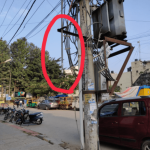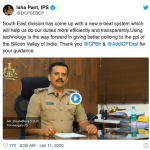Bharat Lal Meena’s life experiences as a civil servant documented in Community Catalyst
Community Catalyst is a novel inspired by the life experiences of former senior bureaucrat and Sector 6 resident of HSR Layout, Bharat Lal Meena. Here is an excerpt from the book published in 2017, and penned by JP Nagar resident and senior journalist Nirmala Govindarajan.

EXCERPT FROM THE BOOK
Following the Sahebru and Vivek to the manicured garden overlooking the main house, Prakash sits cross-legged on the grass, ready to learn all about how the Sahebru has impacted the Bangalore Electricity Supply Company Limited (BESCOM) in Karnataka positively. Nitin follows the trio, and sits on the steps leading to the garden area.
Taking a long sip of chai from a tall mug, Vivek assumes the role of moderator, and says: ‘Now Nitin will tell us what he knows about his Sahebru’s tenure in BESCOM.’
Nitin, who has by this time been adopted into the family says: ‘No Vivek Bhaiya. How could I?’
‘Come on, be a sport,’ chides Vivek.
Nitin looks at the Sahebru, who says: ‘Go on.’ Nitin clears his throat and begins his dramatic rendition: ‘In the beginning, there was electricity in Bangalore. Bills were handwritten, and people paid the said amounts until the year 2003, when a certain new Sahebru assumed responsibility as Managing Director of BESCOM.’
Prakash covers his mouth with his right palm, trying to conceal his laughter. The Sahebru, who is accustomed to his youngest sibling’s playful nature and Nitin’s enthusiasm, laughs, and signals the storyteller to continue.
‘And then the time was ripe for every householder in the metropolitan city of Bangalore to pay his or her electricity bill. Only, now, the person in question arrived at the BESCOM counter with a slip of paper containing some calculations of watts and nots — in other words, the exact amount representing the sum one had to pay for the amount of electricity he or she had utilised,’ narrates Nitin.
Prakash leans forward, waiting for Nitin to continue. Vivek and the Sahebru too, are listening intently. Fully aware that he has a loyal audience in Prakash, Vivek and the Sahebru, Nitin continues his rendition. ‘Soon, a big furore erupted in the BESCOM office. The employees who had been making a buck or two or three or four, even fifty-thousand, perhaps more, via the manual billing system, giving the Department and the honest workers a bad name, were now left with no means to make underhand money. An electric meter had been fixed in every Bangalore household. And an official appointed to document the exact electricity usage by the household every month. All thanks to a certain senior bureaucrat who hails from Sundari,’ Nitin says pointing in the direction of the Sahebru.
‘What I had understood upon assuming this post was the concept of energy audit,’ the Sahebru takes over from Nitin, and goes on to educate Prakash. ‘Energy is like cash, you buy it from someone and sell it to someone else. At the end of the transaction, a proper tally is a must. But then, I found that there were a lot of aspects that were unaccounted for, and the losses for BESCOM were high. So, I went on my customary reconnaissance to conduct my audits, when suddenly, something struck me. I figured that if the point at which the electricity was generated — meaning the transformer were metered, the energy could be transferred via high tension wires to the power supply stations and monitored as well. I had discovered that our people were updating the readings in a very random manner, entering digits according to their own whims and fancies, leaving neither the Department nor the end users in homes with means to verify the discrepancies. Fixing the meter was certainly a viable solution.
‘I further went on to plot a network to indicate the interlinking of various connections. I figured that if the electricity supply is generated from one transformer, and that only those metres attached to it were read by the official on billing duty on any given day instead of conducting random readings, there would be no discrepancies. So, every month, all the readings from transformers and household metres were collated, as a result of which several earlier discrepancies came to light.
‘We kept at it, and within months, BESCOM started saving huge amounts of money, adding up to Rs 500 crores annually. Until then, several BESCOM employees were hand in glove, making their cuts. So when things turned around, almost overnight, there was obvious dissent. But then the change was there for all to witness — BESCOM’s losses had come down to 9% from the earlier 15%. We were faring better than the private power companies, which were documenting a 12% loss. Also internationally, countries that were using the best technologies to keep discrepancies in check, were facing losses of 6 to 7%. So we in Bangalore were actually breaking international records. All this was possible because many offenders in the Department were caught red-handed. Until then, many officials would write the figures in pencil, and then manipulate the digits to their advantage.’
‘Sir, if I recall correctly, you had equipped the officers with hand-held devices,’ says Nitin. ‘Everything went hi-fi and the bills were being generated on the spot. Soon enough, BESCOM became No 1!’
The Sahebru nods in assent. Vivek’s heart brims with pride for his Ram. Prakash’s face is filled with wide-eyed admiration for his bureaucrat uncle, and he wants to hear more about the BESCOM revolution.
‘I was so thankful that the discrepancies in the Department had been put in check, almost overnight,’ says the Sahebru. ‘Before I joined the Department, there was talk of privatising BESCOM. When I gave the Department a facelift, all this talk vanished.’



